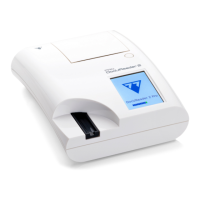2928
Instrument Settings
• For the serial port: The selectable baud rates are 2400, 4800, 9600, 19200,
38400, 57600, and 115200 bits per second. The value defines the speed of
the serial communication. The serial interface specification is 1 (one) stop-bit,
no parity.
• For Output:file option: The transferred data will be saved directly into a file
on the root folder of a USB flash drive connected via a Type A USB port. The
default file name is udr2(%Y%m%d-%H%M%S). (The placeholder string in
parentheses indicates the time of measurement where %Y stands for the year,
%m for the month, %d for the day, %H for the hour, %M for the minute, and
%S for the second.) The file extension is either .csv or .txt, depending on the
selected output protocol.
ǽ For more detailed information about the output settings, please refer to the
full User Manual (See chapter 1.4 How to use this manual).
10.2 Strip options
The main strip options screen shows the available test strip. To modify the strip
settings select the strip type and tap order, sensitivity.
The Settings » Strip » Pads screen will appear, that lists the pads on the strip
corresponding to each analyte that is measured. (See “2.1 Indications for use”
for a key to analyte abbreviations.) The selected pad is marked with a row cursor.
Tap to change the selection. Tap to increase or decrease the sensitiv-
ity of the selected test pad. The sensitivity can be modified between -2 and +2.
ǽ For LabStrip U mALB/CREA test strip, setting sensitivity for ACR and ACR
interpretation is not available.
Tap SED to enable the selected test pad for additional sediment analysis. If the
pad is tagged ‘SED’, all results of the selected pad with a positive value will get a
“sediment examination is recommended” tag when stored in the database. The
tag may also appear on the printout.

